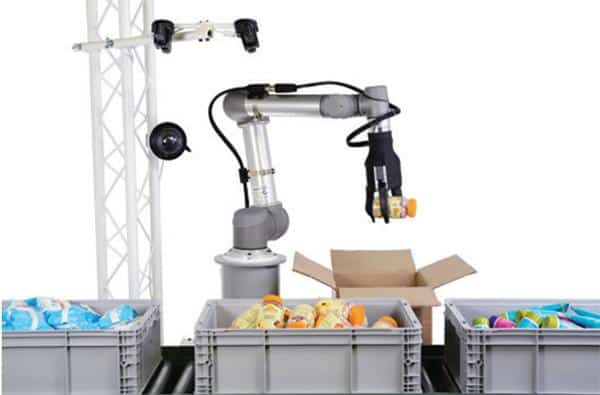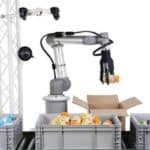The fulfilment sector is becoming increasingly automated. Yet the future isn’t just about robots and automated systems. There are human factors to consider when working out how best to get goods to consumers, reports Sean Fleming Throw a stone in any direction and you’re likely to hit a business only too happy to tell you its people are its most important asset. Yet that self-same business probably also invests more in technology than in any other single area.
Technology is, of course, vital to many organisations. It’s even given rise to whole business sectors. Uber, for example, is built around an app and data. But while not wishing to take away from Uber credit for any of its phenomenal successes and rapid growth, there is an inescapable truth that the taxi alternative has not always had the easiest of rides. Not only have concerns over which rules and regulations should apply to Uber never really gone away, there’s also the human factor to consider.
That’s because, whenever technology pushes at the boundaries of established practices and patterns of behaviour, sooner or later it’s a human being who feels the pressure and maybe even starts to push back a little.
There’s obviously an important balance to be struck between technology and people in any business, but in retail fulfilment this is a particular issue. Customers are challenging retailers and delivery firms alike to meet and exceed expectations where quality, service and speed are concerned. That means businesses need to invest in a process of continuously improving their offerings
Industry 4.0
There exists in some quarters within the retail fulfilment industry a vision of the future where technology is everything. Customers place orders online, items are picked and packed by robots, put on automated conveyors and deposited, ultimately, onto delivery drones that take the purchased item to the customer.
Some of this is already happening, day in, day out. Warehouse automation in particular is nothing new. Indeed, the bells and whistles of City Link’s automated conveyor system were being celebrated not long before it went into administration back in 2014, with the loss of more than 2,000 jobs.
Despite such cautionary tales, automation is important and continues to grow in importance. There is much talk of Industry 4.0 – the next wave in the industrial revolution, where a combination of the Internet of Things and big data drives new systems and new ways of thinking about using automated systems.
In the retail sector, Ocado is one of the most advanced users of automation in its operations: robots, automated conveyor belts, shuttles and cranes are all integral at its three UK distribution centres, the largest of which handles up to 1.3m items per day. A fourth centre is planned for next year.
Shelves are automatically replenished when stocks are running low, and in some cases individual items are picked by robots suspended from hi-tech cabling systems above the shelving area.
Ocado is also involved in a project to develop human-like robots to assist its actual human warehouse staff-members in their work.
Five years ago, Amazon spent US $775m acquiring warehouse robotics company Kiva Systems. This made plain its commitment to and belief in the benefits of robotics long before automation had started to become the mainstream topic it is today.
A flexible friend
The next area in warehouse robotics development will likely revolve around flexibility in general and realistic gripping hands in particular.
Flexibility is a crucial subject because it is integral to one of the biggest potential dilemmas automation throws up. Should retailers invest in a system that can handle the busiest periods – typically but not exclusively November-January – only to have it operating way below optimal rates the rest of the year? Or should retailers invest in something that works well most of the year and needs a helping hand during peak times? Neither is an appealing eventuality.
Being able to focus an automation platform on different tasks and functions as demand dictates would help mitigate some of the concerns about investing large sums of money in what might turn out to be a very efficient one-trick pony.
In the US, RightHand Robotics has recently secured investment funding to support its work in developing what might turn out to be the next wave of warehouse automation technology. The star of the show, if reports are to be believed, will be a gripping hand that functions more like the human hand than anything that’s been seen so far. It has robotic fingers and a suction cup to pick up items, and then put them down again. The system relies on embedded sensors and 3D visual rendering to see, feel and interact with its immediate surroundings.
But as is so often the case where stars of the show are concerned, it’s the hard work behind the scenes that’s made it possible for them to hog the limelight. In the case of RightHand, it’s the use of machine-learning algorithms, designed to make the system operating the gripping hand increasingly smarter, more adaptable and more flexible, that has the most potential to cause ripples. This is because it promises to be able to work with existing robot systems to make them more effective.
That’s hugely important, because one of the other major areas of investment and cost – that is, people – looks like it might have some of the flexibility sucked out of it in the not-too-distant future.
The law catches up
The so-called gig economy is not as new a phenomenon in the retail fulfilment world as it is elsewhere. While this model has turned the taxi sector on its head and opened up a whole world of bicycle-delivered takeaway food, it’s been the backbone of the courier service for years.
But there could now be a real possibility that the widely accepted and used model of hiring people into the industry is going to be dealt a fatal blow. Stories in the media about Uber drivers protesting about pay and conditions are fairly commonplace, a post-ironic echo of many anti-Uber protests held by incumbent taxi drivers’ associations. But having to comply with stringent local by-laws is now forcing Uber out of some major cities; despite 300,000 app users and 2,000 drivers, Uber is reversing out of Denmark, and awaits the outcome of a European Court of Justice ruling on how it should be regulated.
In the UK, Hermes and UK Express are two courier companies that have garnered the ire of the GMB trade union, which argues their self-employed drivers ought to be classed as employees. Sick pay, holiday pay, pension entitlements, minimum wage guarantees and possibly a lot more besides are all potential consequences facing any business – not just Hermes or UK Express – that finds itself in an argument over the legal status of the people that work for it.
In February, the Court of Appeal ruled that a plumbing firm’s self-employed workers were actually nothing of the sort, but were in fact employees who ought to be in receipt of all the usual rights and protections of an employee. Back in January, bicycle courier Maggie Dewhurst won an employment tribunal hearing against CitySprint over holiday pay entitlement.
According to the Financial Times, “Joanna Wade, the judge in the bicycle courier case, ruled… that Ms Dewhurst was a worker and CitySprint had therefore unlawfully failed to pay her for two days’ holiday. She criticised CitySprint’s depiction of its couriers as self-employed people who ‘make their services available’ to the company. ‘Not only is the phrase ‘make their services available’ as opposed to ‘work for’ a mouthful, it is also window dressing,’ she wrote in her judgment.”
So far, no legal precedent has been set regarding the distinction between self-employed and employed workers in the context of the gig economy. But it is hard to imagine this issue simply fading away anytime soon. It had been assumed by many that slow-moving legal systems were going to have to be bent and reshaped to make way for the brave new world of technology-enabled businesses. Certainly, the law could be said to be catching up with technology and its implications for business and employment, but there’s not much evidence of the law bending anytime soon.
A matter of balance
The idea of getting the balance right is something of a cliché when it comes to situations like this. That doesn’t mean one shouldn’t aspire toward balance, of course, but that alone isn’t going to be as much help as retailers would probably like when considering the twin challenges of how
to invest in automation and how best to manage workers.
It’s commonplace practice for retailers to weigh up the competitive landscape, assess the size of a market opportunity and make sure the company is in alignment with customer needs. Less common is the need for retailers to familiarise themselves with an overarching legal and regulatory framework. Such matters tend to change infrequently and can usually be accommodated by small, tactical adjustments.
But in light of the increasing legal interest in the employment status of workers in retail fulfilment jobs, there is now a new game in town. Slow, incremental changes to the law are one thing, but a complete reclassification of employment status is another, the implications of which could be monumental. In the UK, the tax authorities of the HMRC cannot fail to take an interest in the event that a test case should redefine self-employed couriers – and others – as employees.
At a time when uncertainty around the UK’s future trading relationships with Europe and beyond has never been more evident, this level of potential turbulence in employee relations will not be welcomed by many.
Automation is fast becoming an irresistible force, and set against a troublesome people-related backdrop it starts to look more attractive still. Yet retailers should not rush in where even the most tech-savvy angels fear to tread. The Internet of Things offers huge advances where machines monitor, measure and interact with the world around them, but it does not offer a risk-free option, and throws up questions and concerns that need to be treated seriously. Cyber security in the field of connected devices needs to be a priority, for example, as does the more pressing matter of flexibility. After all, there can be little gained from investing many millions in an automated future if shiny new systems lock businesses into a restricted set of operations and activities.






